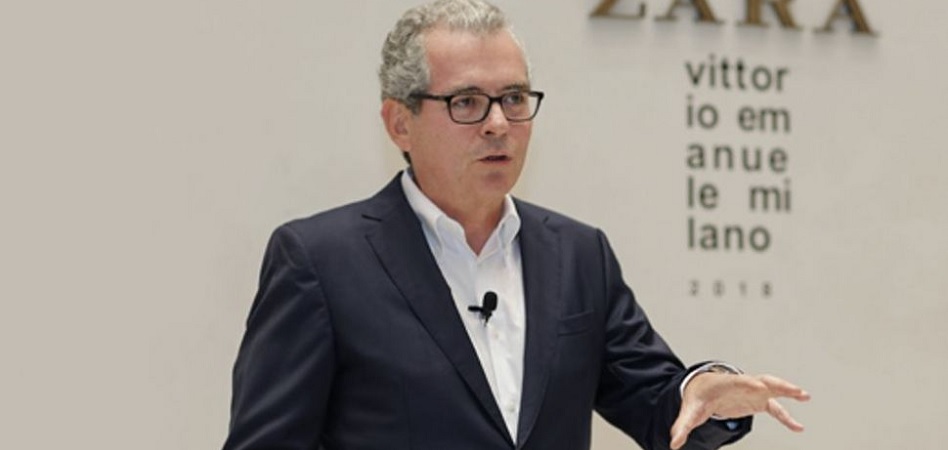Less Black Friday and more profitability: Inditex ‘heals’ accounts with its best margin since 2014
The Spanish fashion group’s gross margin surpassed for the first time the 60% since 2015. “We have answered to a volatile and challenging background without discounts”, explained Pablo Isla.

Zara’s store window during Black Friday. Photograph: Mireia Salgado
No panic. Keep calm and avoid the tyranny of discounts and sales in order to improve damaged margins. That has been the strategy carried out by Inditex during the last few months, in which it has managed to better its gross margin over sales with its highest ratio ever since 2014. “We have answered to a volatile and challenging background without discounts”, synthesised the company’s CEO Pablo Isla yesterday.
In a background in which the fashion business giants have seen their margins reduce in a generalised way induced by the peak of e-commerce or the intense discount activity, analysts warn about a possible loss of profitability within the sector, Inditex included. The reduction of the margin during recent years is, precisely, one of the warnings claimed by Morgan Stanley last August in a report which entailed a severe punishment of Inditex in the stock exchange.
Now, Zara’s parent company has started to turn this trend around. From August to October, the period in which Inditex raised its sales by 1.9% and improved its net profit by 5.5%, the company’s gross margin ascended to 60.5% of the group’s revenue. We are talking about the highest percentage scored during one quarter ever since the third quarter of 2014, when it stood at 61.2%, as well as the first time that it surpasses 60% ever since that same period but of the year 2015.
In 2016, the gross margin of Inditex during the third quarter of the fiscal year (the one which always registers a better profitability compared to the rest of quarters) stood at 59.7%, and, during the same period in 2017, it stood at 59.4%.
In a conference with analysts, Isla recalled yesterday what a huge part of the sector was already noticing, at least in Spain: whilst most of the Spanish group’s competitors embraced, clutching at the last straw, the both saviour and pernicious Black Friday (whether you call it Single’s Day in China or mid-season sales anywhere in the world), Inditex avoided “to participate in the promotional activity widely seen in the sector” focusing instead “on execution”, that is, control of expenses and inventory.
“In a very volatile and challenging environment, we have been able to achieve positive like-for-like “, highlighted Pablo Isla being “naturally” satisfied with the margin evolution of the present fiscal year’s third quarter. “And we think we have taken the right decision, thinking not only about the short term, but thinking also about the medium and the long term”, said he.

Impact of currencies
Whilst the margin is recovered, Inditex reduced the growth of tis sales once more during the third quarter, which ascended an interannual 1.9% compared to the solid growth which it scored in previous months which was of 4.4%.
For the first time after three quarters of adjustments, Inditex raised its number of points of sale around the world between July and October, with twenty more stores. The growth, however, is actually quite moderate in base to the registered during the same period in previous years, when during the third quarter, Inditex opened about 99 stores (as it did in the third quarter of 2017) or 144 points of sales (as it did in the same period of 2016).
In that sense, the slowness of growth will precisely be explained due to the impact of currency exchange rates. For the local currency, the growth of Inditex in the period comprehended from February to October stands at 7%, which nonetheless lowers to 3% attending to the impact of exchange rates.
The same thing happens with the gross operating product: at constant exchange rates, Inditex’s EBITDA would have descended by 9% during the first half-year of the fiscal year, but the effect of the currency reduced such growth by 3%.
Although it references a period that has not ended yet (Inditex presented yesterday its accounts until October 31st), the company claimed that comparable sales grew by 3% in November. “We started this season well with very strong collections. We had an extraordinary warm September that is very well-documented in all the different statistics in the majority of the countries in which we operate. And then you have plus 5% like-for-like in October, November”, stated the group.
This allows the company to keep up its expectations for comparable sales and for the gross margin in the second half of 2018, a period in which it will carry out an extraordinary investment valued in 1.5 billion euros.


info@themds.com
Validation policy for comments:
MDS does not perform prior verification for the publication of comments. However, to prevent anonymous comments from affecting the rights of third parties without the ability to reply, all comments require a valid email address, which won’t be visible or shared.
Enter your name and email address to be able to comment on this news: once you click on the link you will find within your verification email, your comment will be published.